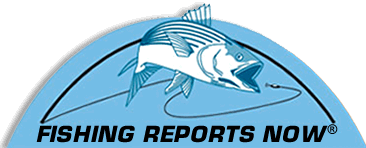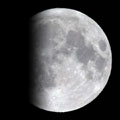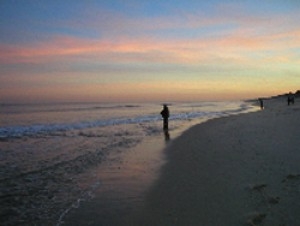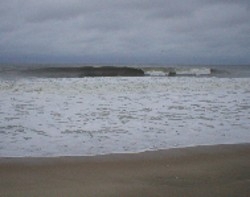The Best of Times in the Cape May Surf |
||
|
If the only goal is to catch fish, surf fishing’s either the best of times or worst of times. When it’s on, it’s on. When it’s off …. It’s the Dead Sea. “People need to learn that it’s not how big or how many,” said Mark Eckel from Jim’s Bait and Tackle in Cape May. Frankly, surf fishing can be more about luck than skill, he said. Still, factors can increase the luck. The location and the right time are the two most important. Let me cut to the chase. The location: Cape May. The time: Right now! In Cape May, surf fishing’s on. Now is the time to catch the largest striped bass of spring in the suds on the point of land, jutting into the confluence of the ocean and Delaware Bay. Plus bluefish are running in and out, and weakfish are sometimes popping up. |
|
Conditions are perfect. The water is 56 degrees, ideal for springtime striper fishing, and the season’s migration of fish—bass, blues, weaks and other usual suspects—is under way through coastal waters. Cape May’s surf fishing is giving up as many catches, including big striped bass, the largest they come, as any beach in the state at the moment. A 43-pound striped bass was weighed in at the shop last week from the town’s wash. But like anyplace in the surf, catches turn off and on. Again, it’s often more about luck than skill, Mark said. Anglers often make the fishing more difficult than they should, he said. Knowing when to hit the suds can help, but only so much. The times keep changing. “Once you think you’ve got it figured out, you don’t,” he said. Surf anglers must put in the time to connect. The sharpie who drilled the 43-pounder fished every morning for two weeks, Mark said. During one two-week period, Mark could look at the clock and know the tide was guaranteed to give up stripers. Surf fishing can be like that. Certain tides, times, conditions will offer the best fishing for a moment, but then it’ll change.
The fish are always moving, looking for food. But general things can be known about the best times. In the past several years that Mark has been fishing the Cape May beaches, May has been the peak of fishing. Stripers will start to wake up after winter and bite as early as April, as water temperatures creep up. The best fishing can last into June. But May is prime, especially for big bass. A few resident stripers, non-migrating fish, usually shorts, live along Cape May’s beaches. But most springtime catches, especially the larger fish, are stripers migrating north. They’re on the move, but Cape May is smack on the highway of the striped bass tour. A roadside rest stop and café, serving up grub. By summertime or late June, many of the fish will have left for cooler waters to the north, and the ones that remain will mostly bite at night, when waters cool a little. The linesiders become sluggish in the heat, just like they become sluggish in the cold of early spring and winter. The best tides can change through the season and according to location. Poverty Beach, probably the most consistent producer of action at the moment, is often best on high tides. But that’s not a rule, and the angler who banked the 43-pounder was fishing low tide at Poverty when he nailed the lunker. Moving tides are usually best, and slack tides can be dead for fishing and are also when skates and sharks grab baits. Mark's advice to keep it simple really come into play with bait and tackle. For striped bass, impale a whole surf clam on the hook. Clams can be dunked in the waters on a fish-finder rig, but Mark fishes a high-low rig when clamming, with one hook 6 or 8 inches from the bottom, and the other hook 6 or 8 inches above that. Chunks of fresh bunker also work. Frozen bunker is usually too soft to keep on a hook, although vacuum-packed, fresh, frozen bunker can Use a fish-finder rig to fish bunker. Chunks from 1 to 2 ½ inches work well. But bunker heads work especially well, for whatever reasons. Maybe the eyes are flashier, or maybe the head is more recognizable to the bass, but who knows? Mark asked. One of the tricks of fishing with bunker is to keep the chunk from spinning in the current. Fish will refuse a bait that’s spinning or looks unnatural. Sometimes anglers are tempted to hook a bunker head through the lips, like they do a live baitfish, but that can promote spinning the most. Mark hooks a head behind the eyes, and that helps prevent spinning. Mark will cast his clams or bunker baits, put the reel in free spool, place the rod in a rod holder, and leave it alone until a striper runs off with the bait, when he grabs the rod and sets the hook.
Mark also keeps on hand for blues metal jigs or spoons like Ava jigs, Hopkins lures, Krocodiles, Kastmasters and Deadly Dicks, durable, tough lures that stand up to the toothy fighters. Again, no need to be complicated. When blues are the target, always tie on either a wire leader or a heavy mono leader, like 80-pound test, to prevent bite offs, Mark said. Weakfish can be the more elusive and scarce fish among the three. But they’ll be found tight to the jetties, right along the rocks. Floating a bloodworm is the popular way to catch weaks on Cape May’s beaches. Mark hooks a bloodworm with a ¼-ounce lead strip 8 inches above and hangs them from a cigar-shaped bobber. The cigar shape offers less resistance when a fish pulls. Try to hang the bait near the bottom, but not on the bottom. Sputnik weights, weights with prongs that hold in the sand but fold back when pulled on the retrieve, are a favorite for Mark. They allow a lighter weight to be used, like maybe a 4-ounce weight instead of a 6-ounce, and hold bottom well. Mark fishes 40-pound PowerPro braided line in the surf. He’s learned to use the line and finds it sensitive, super-strong and less likely to tangle. He throws a 10-foot rod with a 4500 Shimano Baitcaster from the beach and a smaller, 7-1/2-foot rod with a 3500 Baitrunner when casting from the jetties. The smaller rod is easier to handle on the rocks, when the angler usually holds the rod the whole time, and less length is needed to clear the waves when up on the jetties. The whole coast around Cape May, both on the Delaware Bay side and on the ocean side, offers surf fishing. In addition to Poverty Beach, hot spots include Higbee’s Beach, Sunset Beach, Alexander Avenue, Central Avenue behind the convent and Lehigh Avenue. If you think about too many details, become too complicated, the chances of catching decline. Fish the locations, bait, tackle and methods proven to work, fish the best seasons, and fish as much as possible to be there when the fish are there. Sometimes you’ll surely score the worst of times, if your goal is only to catch fish. But can a day watching the water, birds and sky ever be the worst of times for an angler? When you look at it that way, it’s always the best of times. |
||



 “Once you think you’ve
“Once you think you’ve For blues, simply fish a chunk of mackerel, mullet, or other oily, smelly baitfish. A mullet rig is Mark's choice for fishing the meat. Blues are hardly picky, so presentation matters little.
For blues, simply fish a chunk of mackerel, mullet, or other oily, smelly baitfish. A mullet rig is Mark's choice for fishing the meat. Blues are hardly picky, so presentation matters little. 